Dynamisches Gleichgewicht nach BTC-Halbierung: Mining-Einnahmen brechen ein, Shutdown-Preis erreicht $55.000
Originalautorin: Carol, PANews
Bitcoin hat am 20. April seine vierte Halbierung erfolgreich abgeschlossen. Nach dieser Halbierung ist die Blockbelohnung auf 3,125 BTC gesunken. Die Halbierung wird sich zunächst auf die Mining-Industrie auswirken, und die Einnahmen der Miner werden kurzfristig einbrechen. Darüber hinaus wird die Halbierung auch die Inflationsrate von Bitcoin beeinflussen. Der Markt erwartet, dass die zunehmende Knappheit den Preis der Währung weiter in die Höhe treiben wird. Tatsächlich ist Bitcoin jedoch seit der Halbierung immer noch auf hohem Niveau seitwärts unterwegs, mit einem leichten Rückgang von 3,87%, was dazu geführt hat, dass die Miner Stresstests unterzogen wurden und viele kurzfristige Anleger Verluste erlitten haben.
Im Wesentlichen ist jede Halbierung ein weiteres dynamisches Gleichgewicht zwischen Marktangebot und -nachfrage. Welche Trends bei den Marktfonds sind in diesem Neuausgleichsprozess zu beachten? Wie groß ist der Druck auf die Bergbauindustrie? Wie sieht die aktuelle Nachfrageseite von Bitcoin aus? PAData, eine Datenkolumne unter PANews, hat die aktuellen Marktdaten, Bergbaudaten und andere Daten der Nachfrageseite umfassend analysiert und Folgendes festgestellt:
-
Seit März ist der Anteil der Bitcoin-Verlustchips weiter von 1,28% auf 15,18% gestiegen. Nach der Produktionskürzung beträgt der durchschnittliche SOPR-Index kurzfristiger Anleger 0,99972. Viele kurzfristige Anleger haben möglicherweise aufgrund der Erwartung von Produktionskürzungen Verluste erlitten.
-
Nach der Produktionsreduzierung sank die Umlaufrate der Token in der Kette um 231 TP9T, und es werden weitere Chips angesammelt. Aus zeitlicher Sicht hat sich seit diesem Jahr die Anzahl der Chips mit einer Haltedauer von 1 Monat bis 3 Monaten, 3 Monaten bis 6 Monaten und 3 Jahren bis 5 Jahren erheblich erhöht; aus der Perspektive der Halteadressen mit unterschiedlichen Guthaben hat sich die Anzahl der Adressen mit Guthaben zwischen 100 BTC und 1000 BTC und zwischen 1000 BTC und 10000 BTC erheblich um mehr als 1,31 TP9T erhöht.
-
Nach der Produktionskürzung stehen die Bergleute unter größerem Umsatzdruck. Nach dem aktuellen Währungskurs und den höheren Stromkosten wird der Abschaltpreis auf 10 Billionen US-Dollar geschätzt, was einen deutlichen Anstieg gegenüber dem niedrigsten Abschaltpreis von 10 Billionen US-Dollar im August letzten Jahres darstellt.
-
Der aktuelle tägliche Gesamtertrag aus dem Mining beträgt etwa $26,4871 Millionen, was einem Rückgang von 51,63% gegenüber dem durchschnittlichen Tagesertrag von $54,7623 Millionen vor der Halbierung in diesem Jahr entspricht. Die aktuelle tägliche Transaktionsgebühr beträgt etwa $2,28 Millionen, was einem Rückgang von 34% gegenüber der durchschnittlichen Tagesgebühr vor der Halbierung in diesem Jahr entspricht.
-
Unter der Annahme, dass die Einnahmen aus den Transaktionsgebühren unverändert bleiben, das heißt, dass die aktuelle durchschnittliche Transaktionsgebühr und die Anzahl der Transaktionen beibehalten werden, muss der Münzpreis 10.94489,82 US-Dollar erreichen, um das durchschnittliche tägliche Einkommensniveau vor der diesjährigen Halbierung zu erreichen, was einer Steigerung von 51,631 TP9T gegenüber dem aktuellen Münzpreis entspricht.
-
Unter der Annahme, dass der Preis der Währung unverändert bleibt, würde, um das durchschnittliche tägliche Einkommensniveau vor der Halbierung in diesem Jahr zu erreichen, die Anzahl der erforderlichen Transaktionen 1,6737 Millionen erreichen, was einer Steigerung von 202,491 TP9T gegenüber dem Tagesdurchschnitt nach der Halbierung entspricht, oder die durchschnittliche Transaktionsgebühr pro Transaktion würde 0,00080317 BTC erreichen, was einer Steigerung von 206,081 TP9T gegenüber dem Tagesdurchschnitt nach der Halbierung entspricht.
-
Die starke Nachfrage nach Runes zu Beginn der Markteinführung bescherte den Minern enorme Gewinne, da sie am ersten Tag der Markteinführung Transaktionsgebühren in Höhe von 881 BTC beisteuerten.
01. Nach der Produktionsreduzierung stieg der Anteil der verlustbringenden Chips auf 15%, und die Anzahl der Adressen mit großen Währungsbeträgen mit mehr als 100 BTC nahm erheblich zu
Ein potenzieller Marktkonsens ist, dass der Preis von Bitcoin nach der Produktionskürzung stark steigen wird. Historische Daten zeigen, dass der Preis von Bitcoin innerhalb eines Jahres (365 Tage) nach den letzten drei Produktionskürzungen um 8069.11%, 256.85% bzw. 478.10% gestiegen ist.
Kurzfristig wirken sich die Produktionskürzungen bei Bitcoin jedoch nur langsam auf die Preise aus. Kurzfristig (17 Tage) nach den letzten drei Produktionskürzungen stieg der Bitcoin-Preis um 9,731 TP9T, 0,971 TP9T und 6,981 TP9T. Seit dieser Produktionskürzung ist der Bitcoin-Preis jedoch hoch und seitwärts gerichtet geblieben und liegt derzeit (17 Tage) bei etwa 1 TP10T62.400, was einem Rückgang von etwa 3,871 TP9T entspricht.

Der Preis der Währung ist nicht so gut wie erwartet, was zu einem deutlichen Anstieg des Anteils der Verlustchips auf dem Markt geführt hat. Seit der Produktionskürzung schwankt der Preis von Bitcoin zwischen 10T64.900 und 10T62.400 US-Dollar, und der Anteil der Verlustchips ist von 10,951 TP9T auf 15,181 TP9T gestiegen. Tatsächlich ist der Preis der Währung seitwärts tendiert, aber der Anstieg des Anteils der Verlustchips begann vor der Produktionskürzung. Seit März ist der Preis von Bitcoin seitwärts über 10T62.500 US-Dollar tendiert, während der Anteil der Verlustchips von 1,281 TP9T weiter gestiegen ist. Dies bedeutet, dass viele kurzfristige Anleger aufgrund der Erwartung von Produktionskürzungen Verluste erleiden könnten.
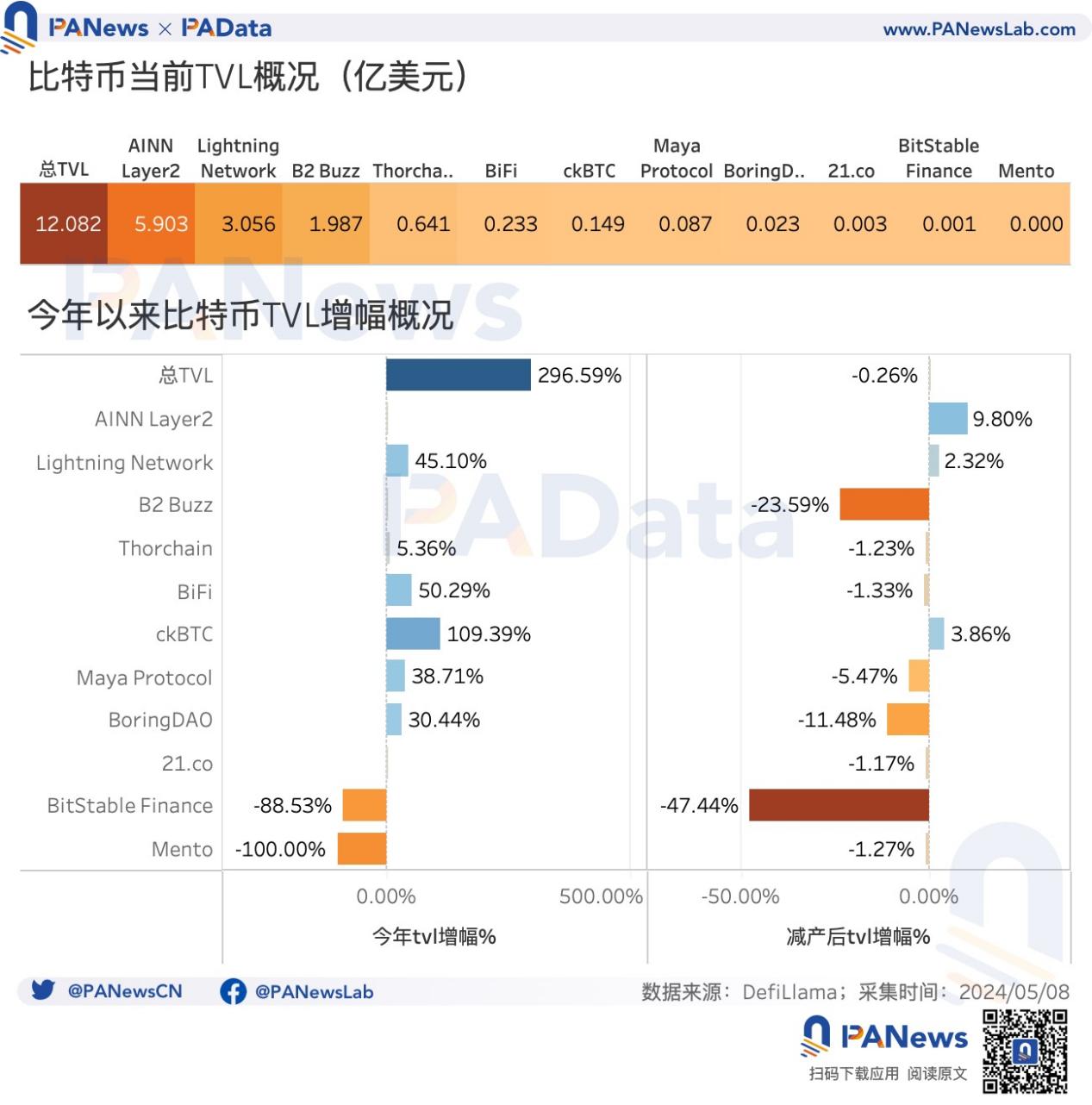
Auch der SOPR-Index kurzfristiger Anleger bestätigt diese Möglichkeit von der Seite. Der Index liegt unter 1, was darauf hinweist, dass Anleger, die Münzen länger als 1 Stunde, aber weniger als 155 Tage halten, im Allgemeinen Geld verlieren. Laut CryptoQuant-Daten liegt der aktuelle Index bei 1,0022, also sehr nahe bei 1, und der Durchschnittswert des Index nach der Reduzierung beträgt 0,99972, was darauf hinweist, dass kurzfristige Anleger in letzter Zeit im Allgemeinen Geld verlieren.
Mit dem Preisverfall verlangsamte sich auch die Zirkulation der Chips in der Kette erheblich. Laut Glassnode-Daten beträgt die aktuelle Zirkulationsrate (Durchschnitt der letzten 7 Tage) 0,01044, was fast 231 TP9T weniger ist als 0,01356 am Tag der Reduzierung und fast 331 TP9T weniger als zu Jahresbeginn, ein deutlicher Rückgang.
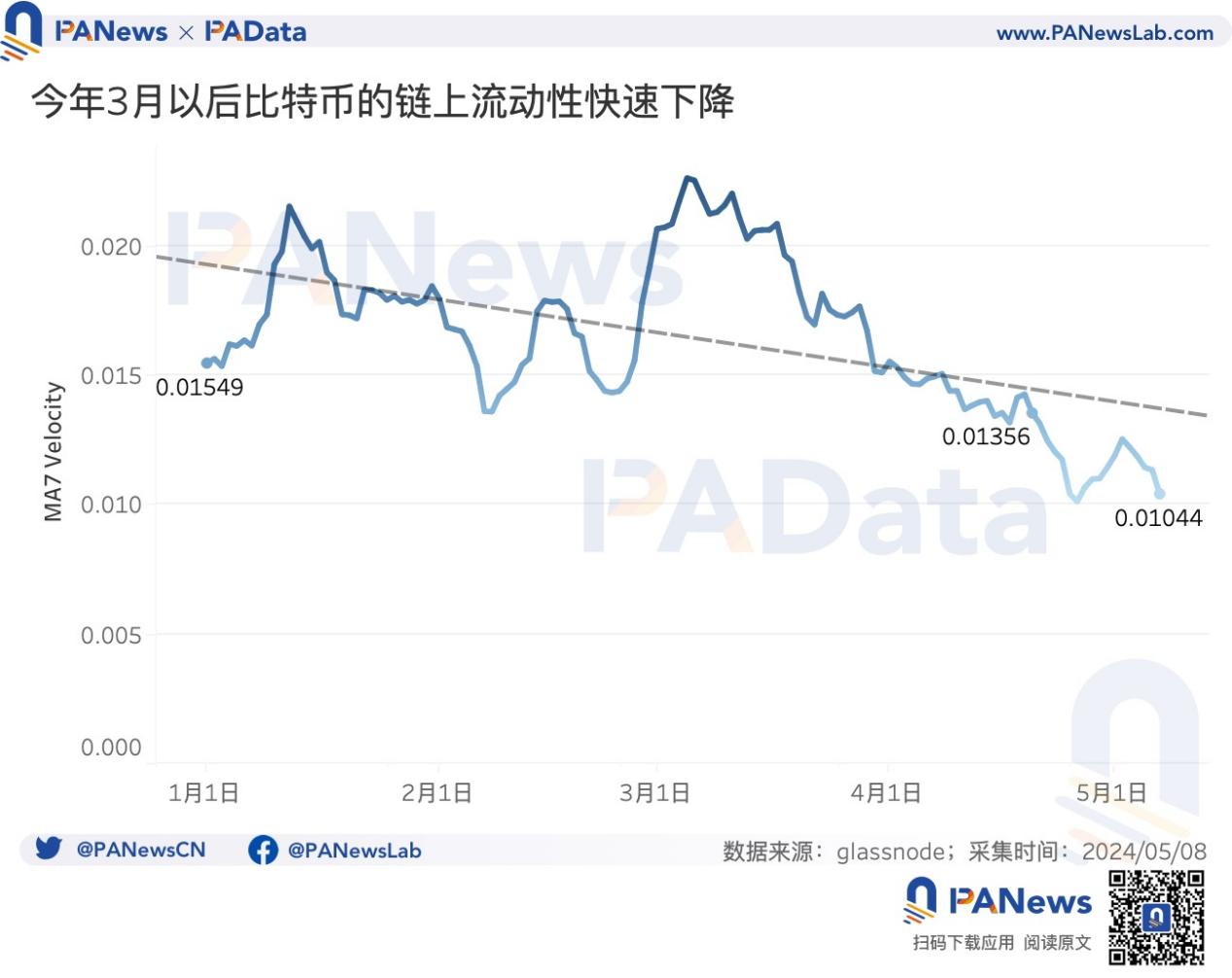
Der schnelle Rückgang der Umlaufrate kann bedeuten, dass mehr Chips im Anhäufungsprozess sind. Aus der Perspektive des Zeitzyklus ist die Anzahl der Chips mit einer Haltedauer von 1 Monat bis 3 Monaten, 3 Monaten bis 6 Monaten und 3 Jahren bis 5 Jahren seit diesem Jahr deutlich gestiegen. Insbesondere ist der Anteil der Chips, die 1 Monat bis 3 Monate gehalten werden, in diesem Jahr um 7,14 Prozentpunkte und nach der Halbierung um 2,44 Prozentpunkte gestiegen, was auf einen Trend der Anhäufung von kurzfristigen zu mittel- und langfristigen Haltedauern hindeutet.
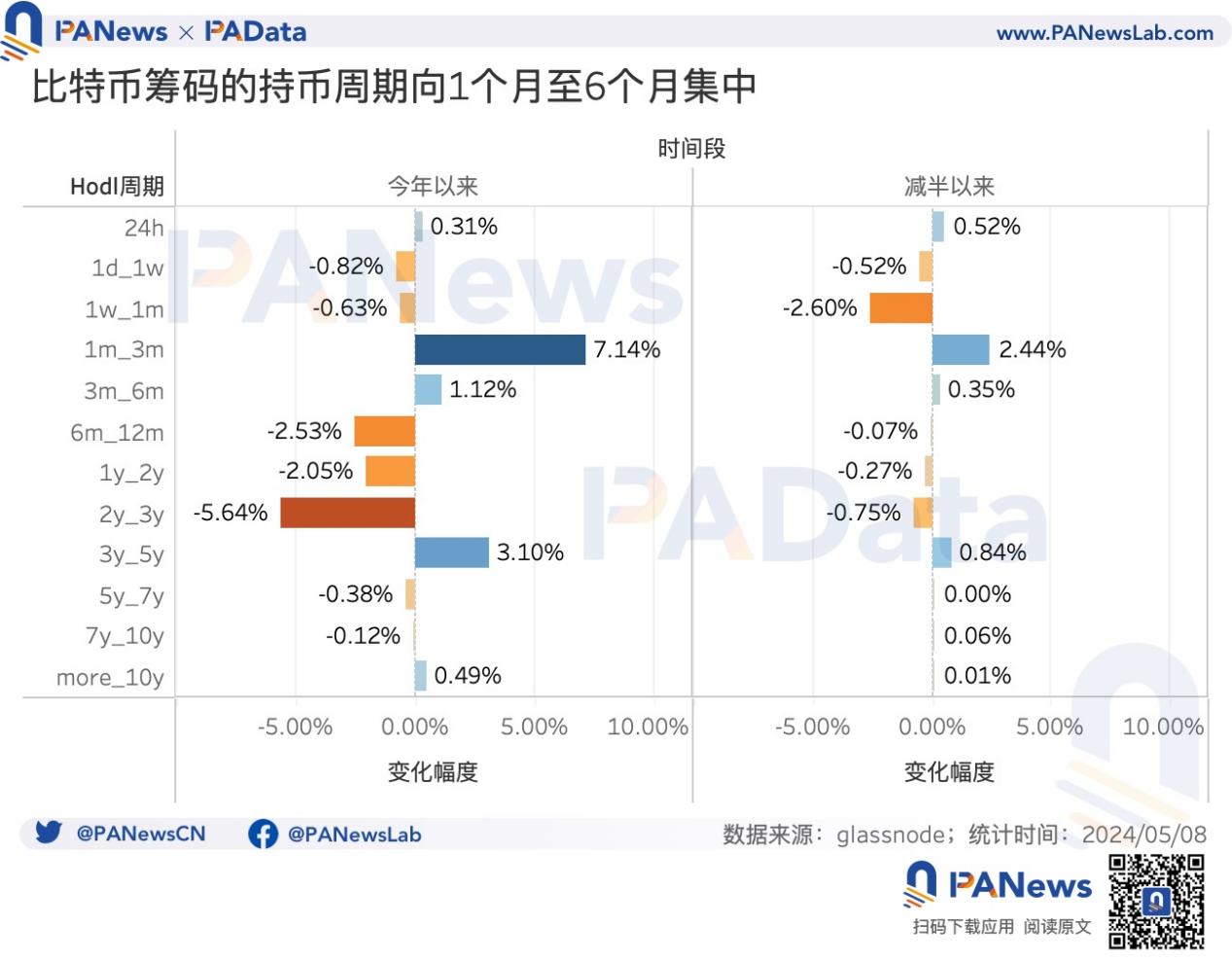
Aus der Perspektive der Adressen mit unterschiedlichen Guthaben, die Währungen halten, ist seit Anfang dieses Jahres unter den als Entitäten gekennzeichneten Adressen (bezogen auf den Adresscluster, der von derselben Netzwerkeinheit kontrolliert wird, wie z. B. Börsenadressen, Stiftungsadressen, Waladressen, Miner-Adressen usw.) die Anzahl der Adressen mit Guthaben zwischen 100 BTC und 1000 BTC und zwischen 1000 BTC und 10000 BTC deutlich gestiegen, und zwar um 1,351 TP9T bzw. 1,391 TP9T, und dieses Phänomen besteht auch nach der Halbierung noch. Unter allen Adressen ist die Anzahl der Adressen mit Guthaben zwischen 1000 BTC und 10000 BTC um 1,071 TP9T gestiegen. Diese Daten zeigen, dass die Anzahl der Großhalter steigt und die Chips im Ansammlungsprozess sind.
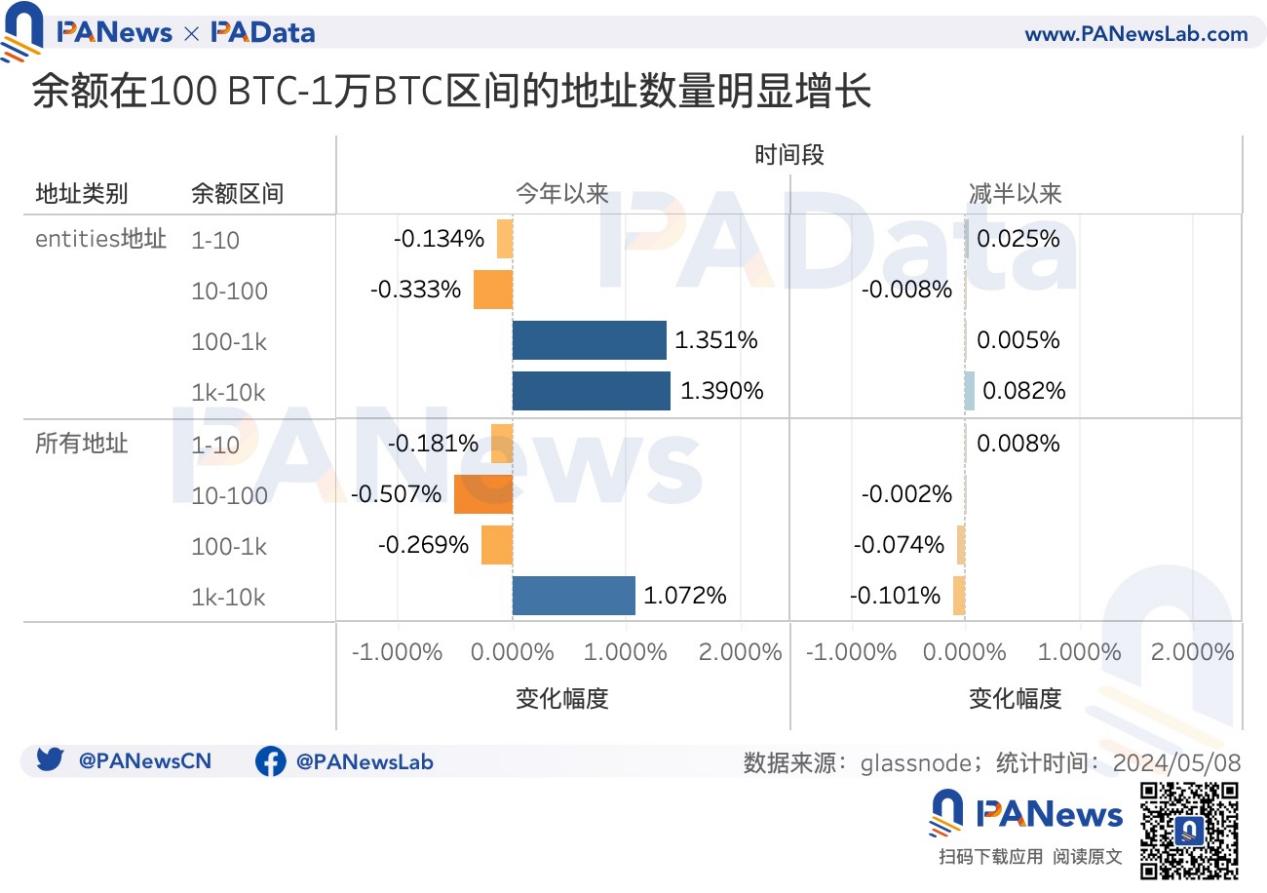
02. Nach der Produktionsreduzierung sank die Rechenleistung um mehr als 7% und das tägliche Bergbaueinkommen sank auf 26,49 Millionen US-Dollar
Nach der Kürzung der Bitcoin-Produktion ist die gesamte Rechenleistung des Netzwerks (die durchschnittliche Rechenleistung der letzten 7 Tage) deutlich gesunken. Laut Glassnode-Daten beträgt die aktuelle Rechenleistung 582,2 EH/s, was 7,431 TP9T weniger ist als am Tag der Produktionskürzung. Der Rückgang der Rechenleistung übersteigt den Preisverfall der Währung, was darauf hindeuten könnte, dass die Miner einige Mining-Maschinen abgeschaltet haben, um die Zinssätze aufrechtzuerhalten.
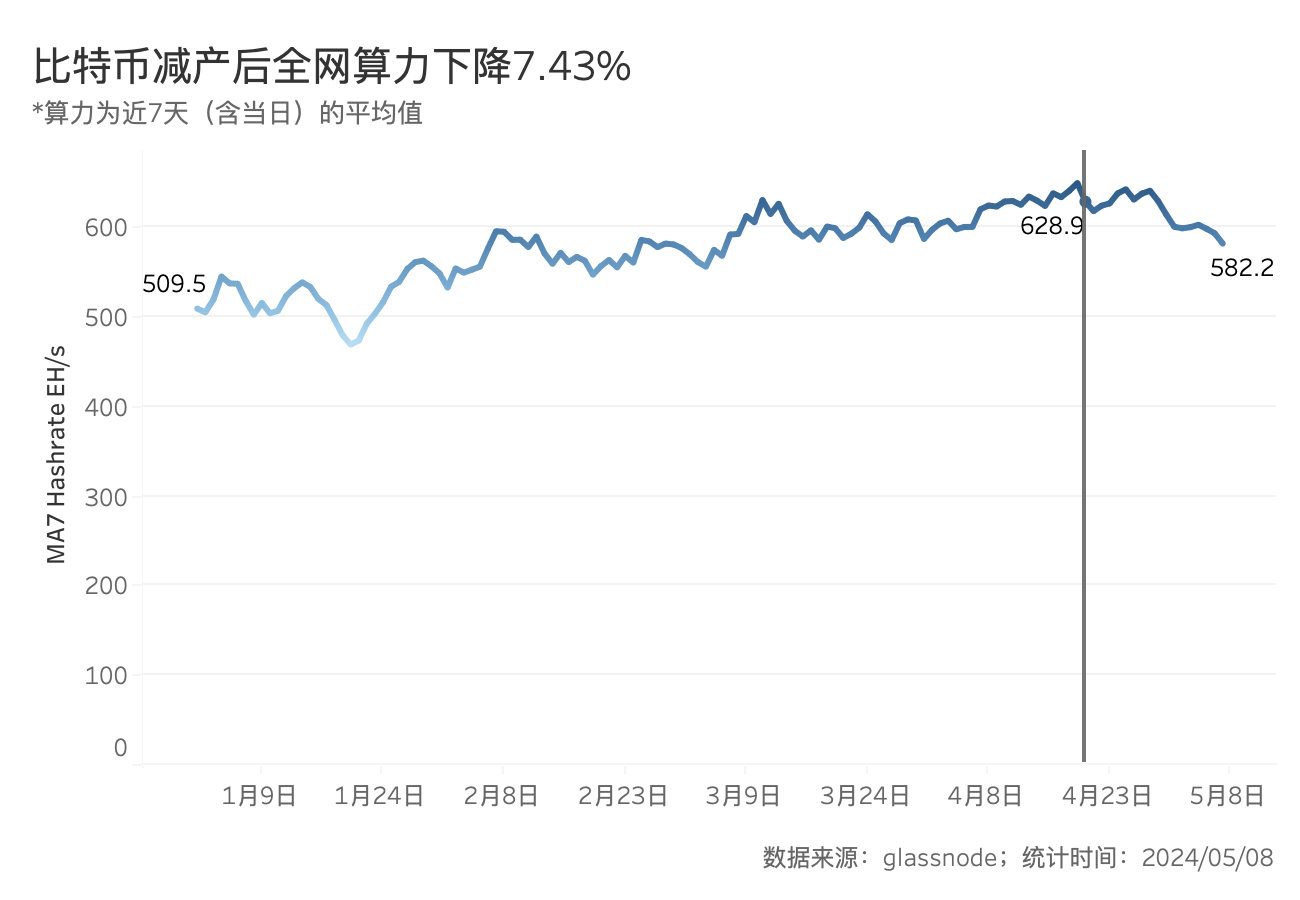
Den Daten von f2pool zufolge stehen die Miner derzeit unter großem Umsatzdruck, wenn man die Abschaltpreise verschiedener Mining-Maschinen betrachtet. Laut dem Münzpreis von $62.315,29 am Tag der Datenerfassung ist der Abschaltpreis niedriger als der aktuelle Münzpreis, wenn sich die Mining-Maschine in einem Gebiet mit niedrigeren Stromkosten befindet und eine Gebühr von $0,07 pro 10 Millionen angenommen wird. Es gibt 31 Mining-Maschinenmodelle, die immer noch Gewinne erzielen können. Unter ihnen hat der Ant S 21 Pro den niedrigsten Abschaltpreis von $32.200 und einen täglichen Nettoumsatz von $5,52. Laut Daten von BTC.com lag der niedrigste Abschaltpreis im August letzten Jahres noch bei $14.300.
Befindet sich die Mining-Maschine in einem Gebiet mit höheren Stromkosten, gibt es bei einer angenommenen Gebühr von $0,12/kWh nur drei Mining-Maschinenmodelle, die noch rentabel sein können: Antminer S 21 Pro, Antminer S 21 Hyd und Antminer S 21 mit einem Abschaltpreis von über $55.200.
Wenn sich die aktuellen Marktbedingungen nicht verbessern, wird der Strompreis ein wichtiger Faktor sein, der über Leben und Tod der Bergleute entscheidet. Wenn sich die Marktbedingungen verbessern, inwieweit wird der Druck auf die Bergleute nachlassen?

Unter der Annahme, dass die Stromkosten niedrig bleiben, wird bei einem Anstieg des Münzpreises auf $80.000 die Anzahl rentabler Mining-Maschinen 45 erreichen, der niedrigste Abschaltpreis ist nach wie vor der Antminer S 21 Pro und der höchste tägliche Nettoertrag ist der Shenma M 63 S (390 T) und erreicht $12,30. Wenn der Münzpreis auf $100.000 steigt, wird die Anzahl rentabler Mining-Maschinen 66 erreichen, der niedrigste Abschaltpreis ist der Antminer S 21 Pro und der höchste tägliche Nettoertrag ist der Shenma M 63 S (390 T) und erreicht $18,41. Wenn der Münzpreis steigt, erhöht sich die Anzahl der für Miner verfügbaren Arten von Mining-Maschinen erheblich und sie können auf verschiedene Arten konfiguriert werden.
Nach der Halbierung sind die Einnahmen aus dem Mining stark gesunken. Laut CryptoQuant-Daten beträgt der aktuelle tägliche Gesamtumsatz aus dem Mining etwa $26,4871 Millionen, was einem Rückgang von 51,631 TP9T gegenüber dem durchschnittlichen Tagesumsatz von $54,7623 Millionen vor der Halbierung in diesem Jahr entspricht. Es ist jedoch erwähnenswert, dass der Mining-Umsatz am Tag der Halbierung aufgrund der Einführung des Runes-Protokolls etwa $107 Millionen betrug und damit 95,061 TP9T höher war als der durchschnittliche Tagesumsatz vor der Halbierung in diesem Jahr.
Der starke Anstieg der On-Chain-Nachfrage kann die Verluste der Miner durch die Halbierung durch Transaktionsgebühren ausgleichen. Am Tag der Einführung von Runes erreichten die Transaktionsgebühren 80,58 Millionen US-Dollar, was 751 TP9T des Gesamtumsatzes ausmachte. Da die Popularität von Runes jedoch abkühlte und das Transaktionsvolumen zurückging, beträgt die aktuelle tägliche Transaktionsgebühr etwa 2,28 Millionen US-Dollar, ein Rückgang von 341 TP9T gegenüber der durchschnittlichen täglichen Gebühr vor der Halbierung in diesem Jahr.
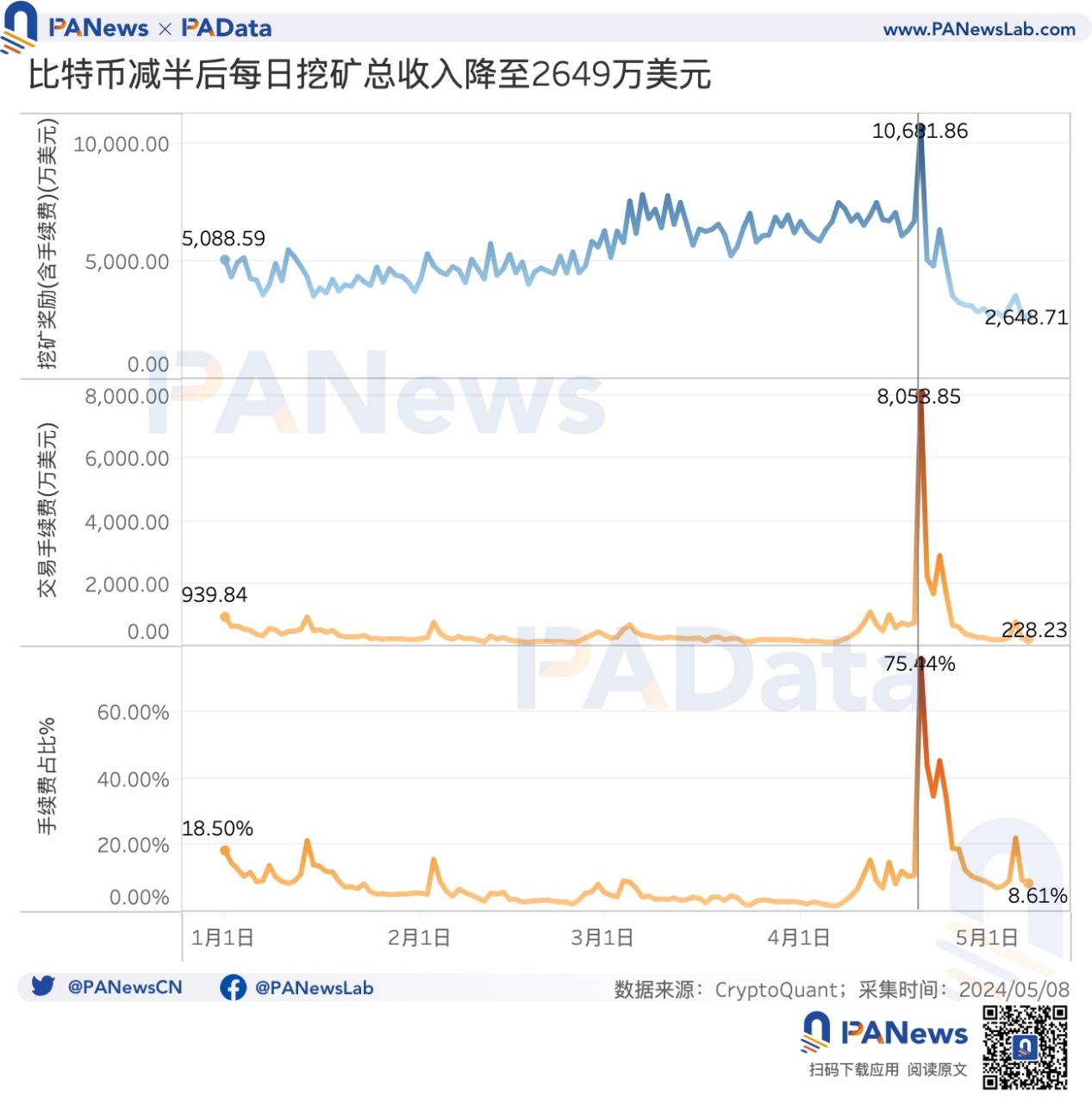
Mining-Einkommen der Miner (USD) = (Blockbelohnung + Transaktionsgebühr) * Münzpreis, daher kann die durch die Halbierung verursachte Verringerung des Miner-Einkommens auf zwei Arten direkt kompensiert werden. Erstens muss der Münzpreis unter der Annahme, dass die Transaktionsgebühreneinnahmen unverändert bleiben, stark steigen. Zweitens müssen die Gebühreneinnahmen unter der Annahme, dass der Münzpreis grundsätzlich stabil ist, stark und kontinuierlich steigen. Natürlich handelt es sich hierbei um eine einfache statische Analyse, deren Zweck es ist, die möglichen Auswirkungen der Bitcoin-Halbierung auf den Münzpreis und die Transaktionen aufzuzeigen.
Laut CryptoQuant-Daten betrug das durchschnittliche tägliche Mining-Einkommen vor der Halbierung $54,76 Millionen US-Dollar und das durchschnittliche tägliche Blockvolumen nach der Halbierung 139 Blöcke, d. h. die durchschnittliche Blockbelohnung nach der Halbierung betrug 434,23 BTC, die durchschnittliche Transaktionsgebühr nach der Halbierung betrug 0,0002624 BTC und die durchschnittliche tägliche Gesamtzahl der Transaktionen nach der Halbierung betrug 553.328,19 Mal.
Unter der Annahme, dass die Einnahmen aus den Transaktionsgebühren unverändert bleiben, das heißt, dass die aktuelle durchschnittliche Transaktionsgebühr und Anzahl der Transaktionen beibehalten werden, muss der Münzpreis 10.94489,82 US-Dollar erreichen, damit die Miner vor der diesjährigen Halbierung das durchschnittliche Tageseinkommensniveau erreichen, was einer Steigerung von 51,631 TP9T gegenüber dem aktuellen Münzpreis entspricht.
Unter der Annahme, dass der Währungspreis unverändert bleibt und die Transaktionsgebühr unverändert bleibt, wären für das durchschnittliche tägliche Einkommensniveau vor der diesjährigen Halbierung 1,6737 Millionen Transaktionen erforderlich, was einer Steigerung von 202,491 TP9T gegenüber dem Tagesdurchschnitt nach der Halbierung entspricht.
Unter der Annahme, dass der Münzpreis unverändert bleibt und die Anzahl der Transaktionen unverändert bleibt, würde das durchschnittliche tägliche Einkommensniveau vor der diesjährigen Halbierung eine durchschnittliche Transaktionsgebühr von 0,00080317 BTC erfordern, was einer Erhöhung von 206,081 TP9T gegenüber dem Tagesdurchschnitt nach der Halbierung entspricht.
03. Die Nachfrage nach Bitcoin bleibt schwach, TVL und Runes fallen
Man geht davon aus, dass die Auswirkungen der Halbierung auf die Mining-Industrie erheblich sind und unrentable Miner eine Bedrohung für die zugrunde liegende Sicherheit der Blockchain darstellen werden. Neben dem Preis der Währung spiegeln Transaktionsgebühren und Transaktionszeiten die Nachfrage direkt wider. Wie hoch ist also die aktuelle Nachfrage nach Bitcoin?
Aus der Perspektive von Runes ist die Anzahl der damit verbundenen Transaktionen laut den Dashboard-Daten von @cryptokoryos in Dune Analytics von anfänglich 463.600 auf derzeit 79.400 gesunken und die Bearbeitungsgebühr ist von 881 BTC auf derzeit 4 BTC gesunken. Anhand der täglichen Mining-Einnahmen können wir erkennen, dass die starke Nachfrage nach Runes zu Beginn seiner Einführung den Minern enorme Gewinne bringen kann. Die Frage ist nun, wie die Nachhaltigkeit der Nachfrage nach verschiedenen Bitcoin-Projekten wie Runes aufrechterhalten werden kann.
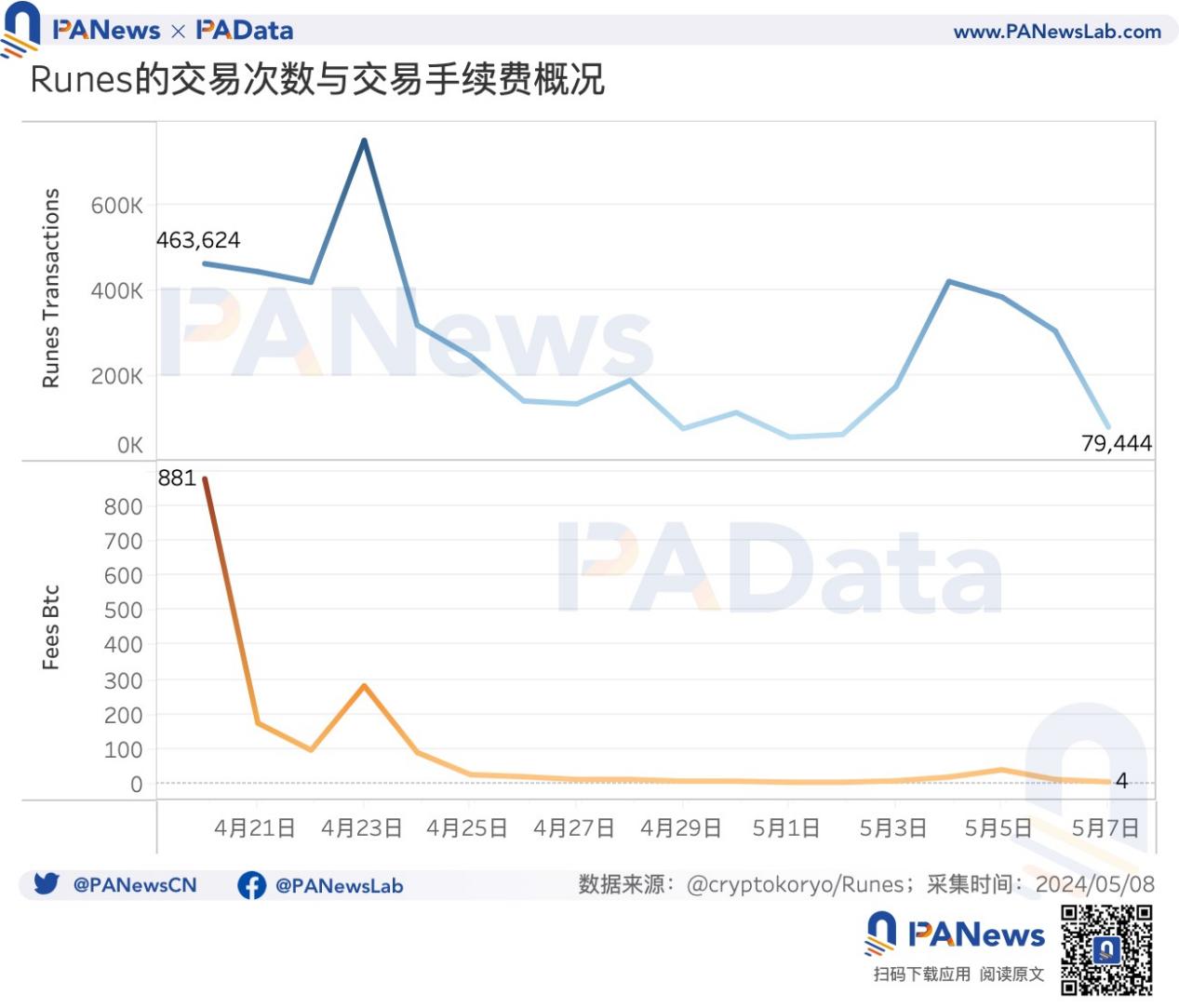
Darüber hinaus könnte die DeFi-Fantasie, die Bitcoins Layer 2 und Runes mit sich bringen, auch die Nutzungsnachfrage anregen. Laut DefiLIama-Statistiken hat der aktuelle TVL in der Bitcoin-Kette derzeit 1,208 Milliarden US-Dollar erreicht, ein Anstieg von 296% seit Jahresbeginn, und ist nach der Halbierung im Wesentlichen stabil geblieben. Darunter hat neben dem Lightning Network auch der kürzlich eingeführte AINN Layer 2 eine gute Leistung gezeigt und einen aktuellen TVL von 590 Millionen US-Dollar erreicht, was ihn zur Hauptanwendung im Bitcoin-Ökosystem macht. Darüber hinaus haben Anwendungen wie BiFi, Maya Protocol und BoringDAO in diesem Jahr ebenfalls ein schnelles TVL-Wachstum erzielt.
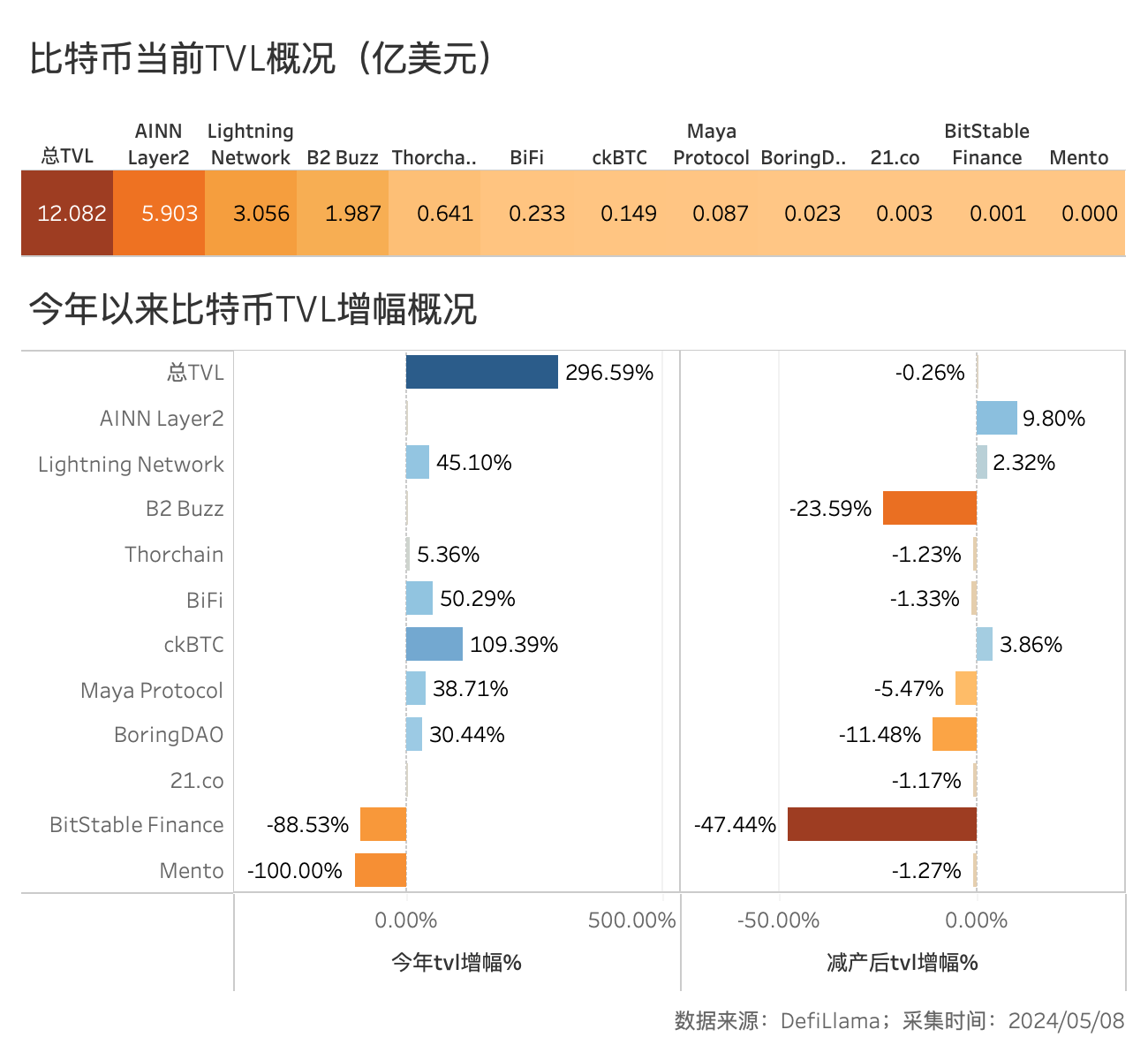
Dieser Artikel stammt aus dem Internet: Dynamisches Gleichgewicht nach BTC-Halbierung: Mining-Umsatz stürzt ab, Shutdown-Preis erreicht $55.000
Verwandte Themen: Ein Überblick über die Entwicklung des Liquiditäts-Stakings auf Solana
Originalautor: Tom Wan, On-Chain-Datenanalyst Originalübersetzung: 1912212.eth, Foresight News Die Liquiditätsverpfändung im Ethereum-Ökosystem hat eine Welle von Verpfändungen ausgelöst, und selbst jetzt ist die Neuverpfändungsvereinbarung in vollem Gange. Ein interessantes Phänomen ist jedoch, dass sich dieser Trend nicht auf andere Ketten auszubreiten scheint. Der Grund dafür ist, dass neben dem enormen Marktwert von Ethereum, der immer noch einen erheblichen Vorteil einnimmt, welche anderen tief verwurzelten Faktoren am Werk sind? Wenn wir unsere Implementierung auf Solana und die Liquiditätsverpfändungsvereinbarung auf Ethereum anwenden, wie ist der aktuelle Entwicklungstrend von LST auf Solana? Dieser Artikel wird Ihnen das ganze Bild enthüllen. 1. Obwohl die Verpfändungsrate über 601 TP5T liegt, stammen nur 61 TP5T (1 TP6T3,4 Milliarden) der verpfändeten SOL aus Liquiditätsverpfändungen…







